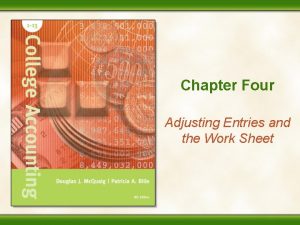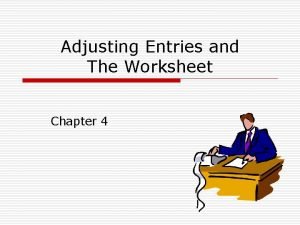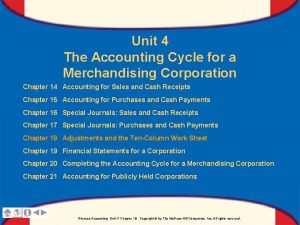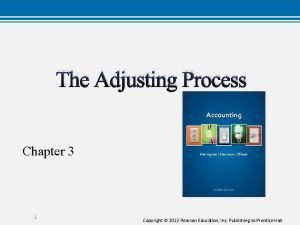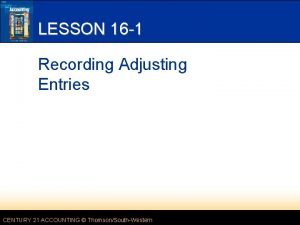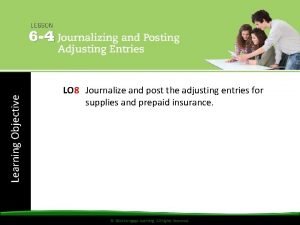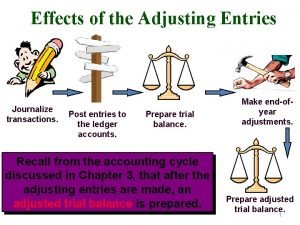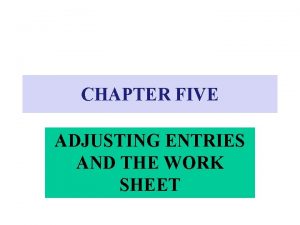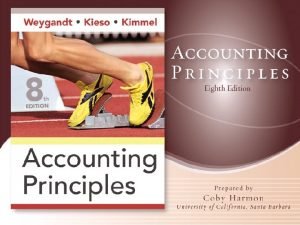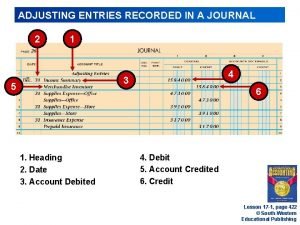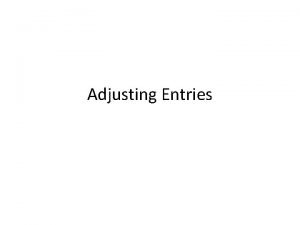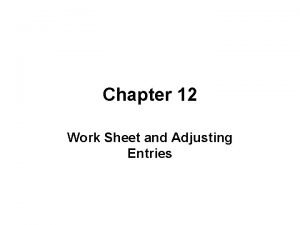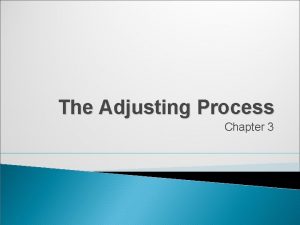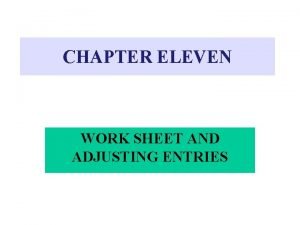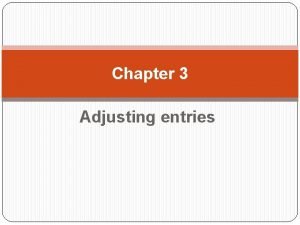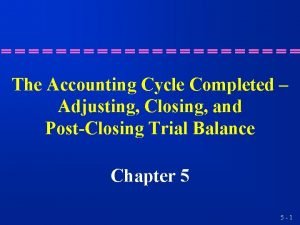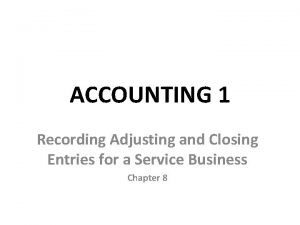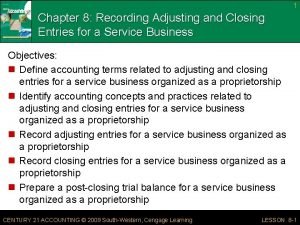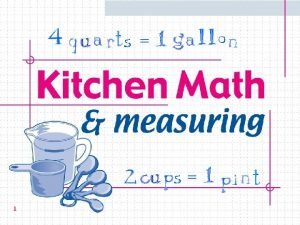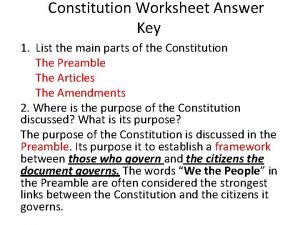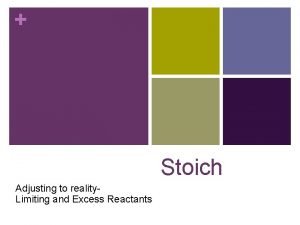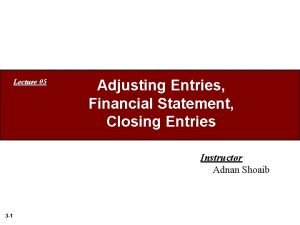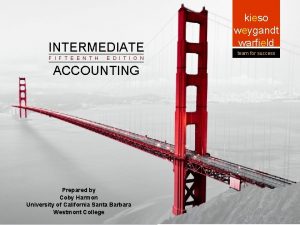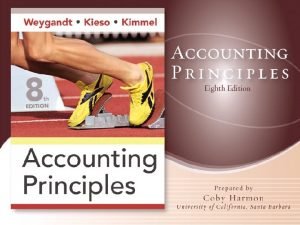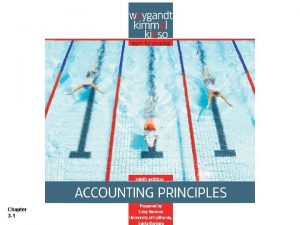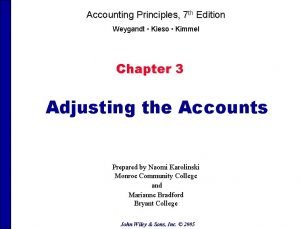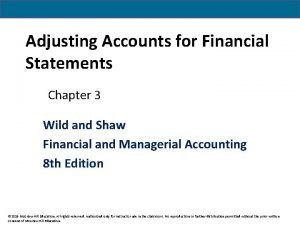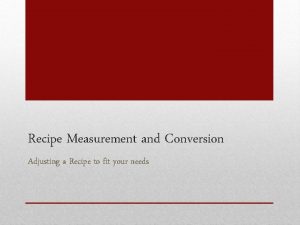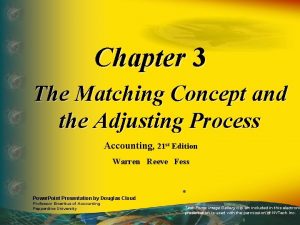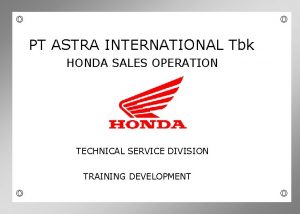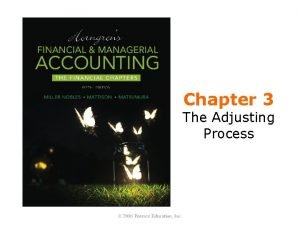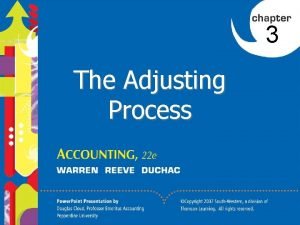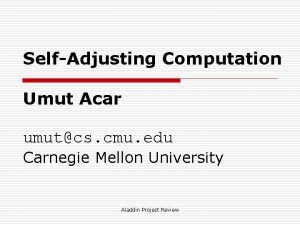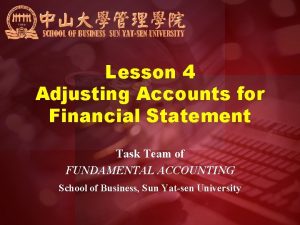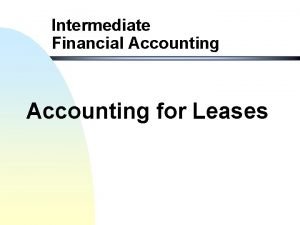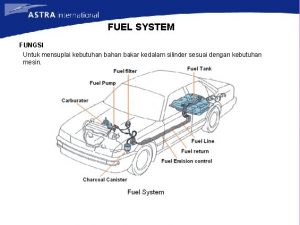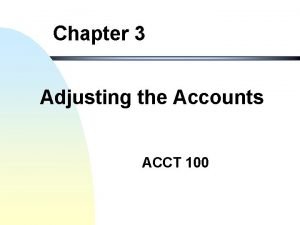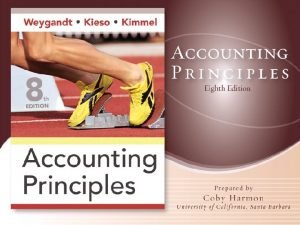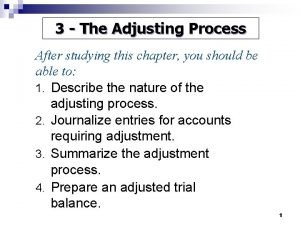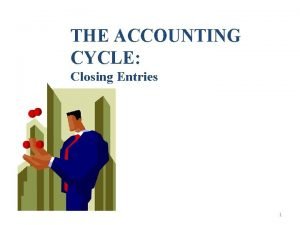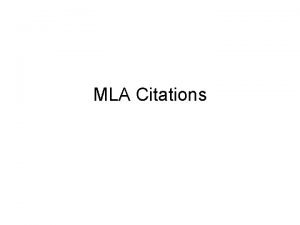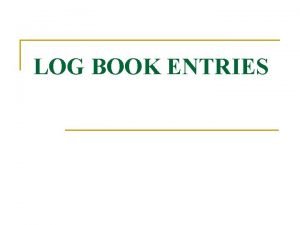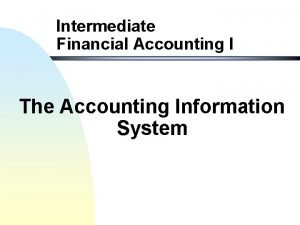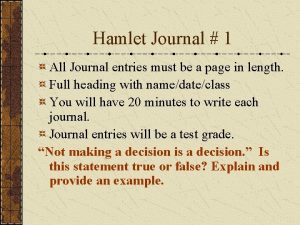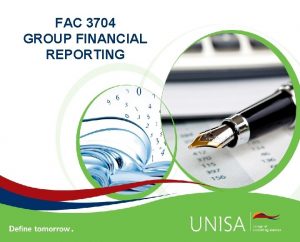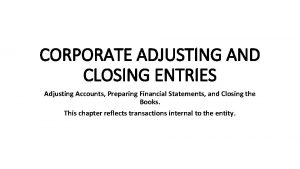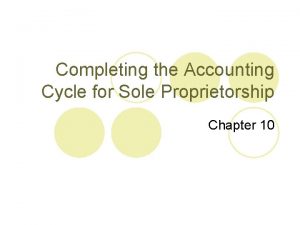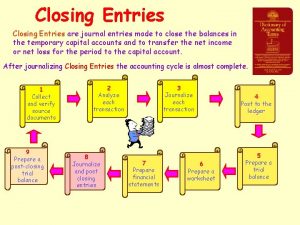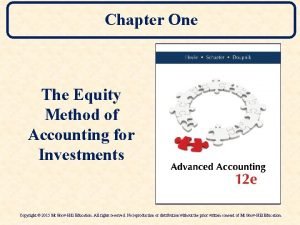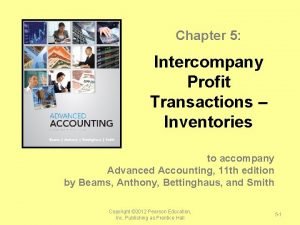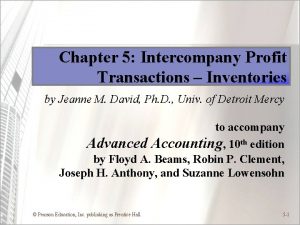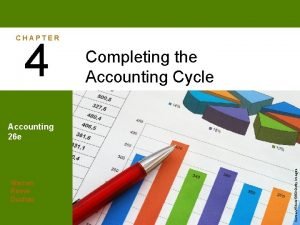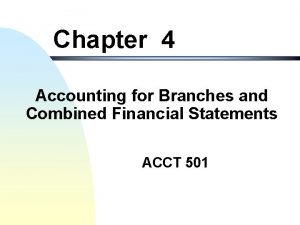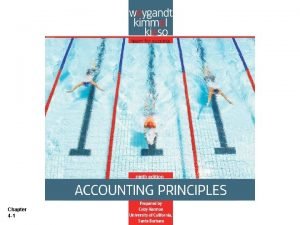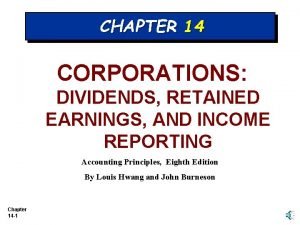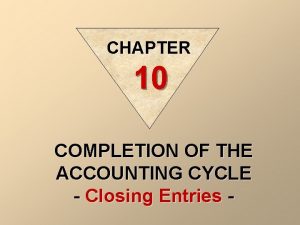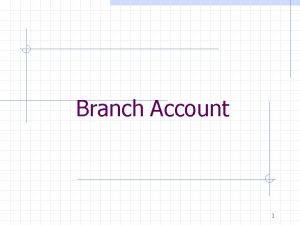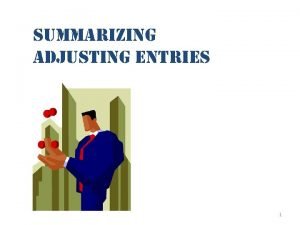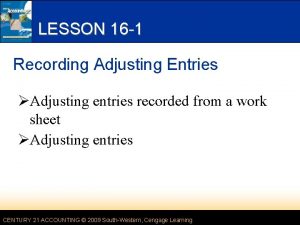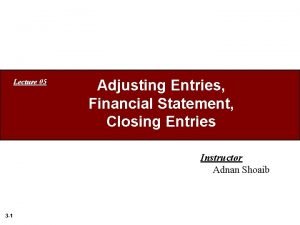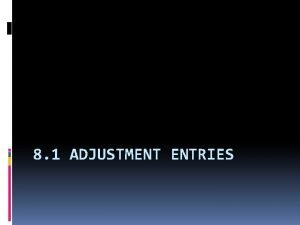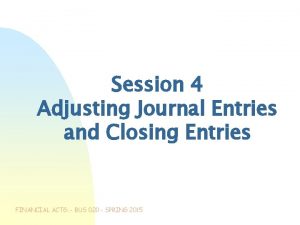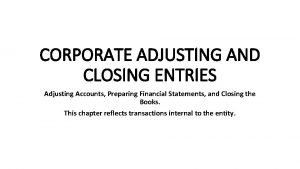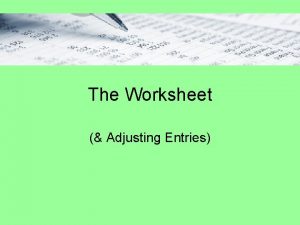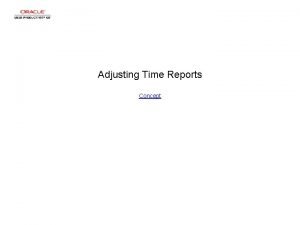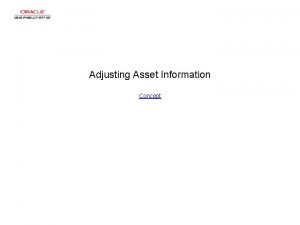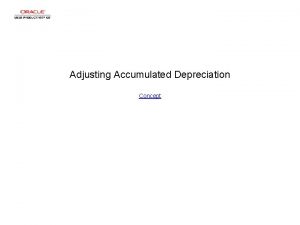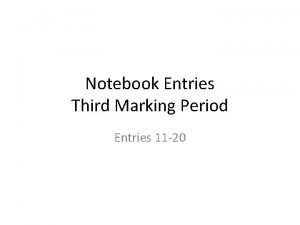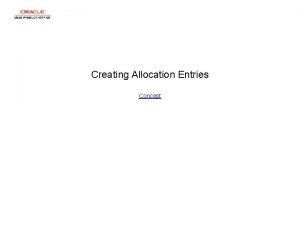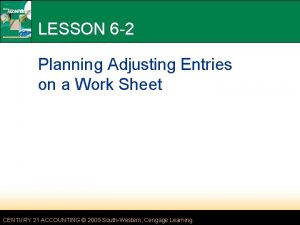Lecture 14 Adjusting Entries Worksheet Lecture 14 Adjusting

















































































- Slides: 81

Lecture #14: Adjusting Entries & Worksheet

Lecture #14: Adjusting Entries & Worksheet

Lecture #14: Adjusting Entries & Worksheet

LECTURE # 13 SUMMARY Lecture #14: Adjusting Entries & Worksheet

SUMMARY OF THE LECTURE # 7 § That the company is a going concern. § That revenue should be recognized in the accounting period in which it is earned. § In accrual accounting, revenues and expenses are recorded when they are earned or incurred Lecture #14: Adjusting Entries &

Completion of the Accounting Cycle Lecture #14: Adjusting Entries & Worksheet

Adjustments, Financial Statements, and Financial Results Lecture #14: Adjusting Entries & Worksheet

LECTURE 14 Lecture #14: Adjusting Entries & Worksheet

Adjusting Entries and The Worksheet Lecture #14: Adjusting Entries & Worksheet

Learning Objectives 1. Identify annual accounting activities that make year-end the “busy season” 2. Explain the purpose of adjusting entries. Lecture #14: Adjusting Entries & Worksheet

Learning Objectives 3. Describe and prepare the basic four types of adjusting entries. 4. Explain practically the concept of “materiality”. 5. Explain the concept of adequate disclosure. Lecture #14: Adjusting Entries & Worksheet

Learning Objectives 6. Explain how interim financial statements are prepared in a business that closes its accounts only at year-end. 7. Preparing a worksheet explain its usefulness. Lecture #14: Adjusting Entries & Worksheet and

Learning Objective 1 Explain why adjustments are needed. 4 -13

Expected Learning Outcomes • List the classifications of the accounts that occupy each column of a tencolumn worksheet • Complete a worksheet for a service enterprise • Journalize and post adjusting entries • Prepare statements from worksheet Lecture #14: Adjusting Entries & Worksheet

Fiscal Period • Period of time covering a complete accounting cycle through closing entries • A day, week, month, whenever you want • Monthly is normal for comparison purposes • Fiscal year – Complete cycle for 12 months – Need not coincide with calendar year Lecture #14: Adjusting Entries & Worksheet

The 10 -Column Worksheet • Working paper – Simply a tool used for accounting – To record necessary updates for financial statements • Central place for bringing together information for adjustments Lecture #14: Adjusting Entries & Worksheet

Ten Column Worksheet • 10 columns for recording dollar amounts • 2 columns for each heading (debit/credit) – – – Trial balance Adjustments Adjusted trial balance Income Statement Balance Sheet Lecture #14: Adjusting Entries & Worksheet

Trial Balance Columns • A listing of each account in the order of – Assets – Liabilities – Owner’s equity – Revenue – Expenses Lecture #14: Adjusting Entries & Worksheet

Trial Balance Columns • Noting the balance in each account • Foot the debit and credit columns and make sure they balance • If you are not in balance, fix it here before continuing Lecture #14: Adjusting Entries & Worksheet

Adjustments • These update the ledger accounts • Internal transactions where no money has changed hands…. cash is NOT involved • Cash account is NEVER used in adjustment columns Lecture #14: Adjusting Entries & Worksheet

Adjustment Example Paid $360 for Insurance for 1 Year on February 1 Analyze the transaction – Debit Prepaid Insurance $360 – Credit Cash $360 • March 1 st – How have the accounts changed? – $360/12 = $30 of Prepaid Insurance used – Insurance Expense increased $30 Lecture #14: Adjusting Entries & Worksheet

Depreciation • Depreciation Expense is recorded every period that an asset was in use • This “expenses” the cost of the asset over its useful life • At the end of its use, an asset has a “trade-in value” or salvage value. Lecture #14: Adjusting Entries & Worksheet

Depreciation • The amount in the asset account is the cost of the asset until disposed • The amount in the asset account minus the amount in the Accumulated Depreciation account is called “book value” • Depreciation is not deducted directly from the asset account – a new account called “Accumulated Depreciation” is created for each asset. This way, you can see on the balance sheet how much of the asset has expired. Lecture #14: Adjusting Entries & Worksheet

Depreciation of Equipment • Estimated useful life of equipment is 7 years • Estimated value of equipment at end of 7 years is $6, 880 (trade-in or salvage value) • Cost of equipment ($49, 720) minus trade-in value ($6, 880) divided by the number of years of use (7) is the annual depreciation • This annual depreciation is divided by 12 to get the Depreciation Expense amount for each month (continued next slide) Lecture #14: Adjusting Entries & Worksheet

Depreciation Example Bought Equipment for $49, 720 • $49, 720 - $6, 880 (trade-in) = $42, 840 • $42, 840 / 7 years = $6, 120 per year • Divide the depreciation for one year by 12 to get the depreciation for one month ($6, 120 per year / 12 = $510 per month) • Each month the depreciation expense is recorded in Depreciation Expense as a debit of $510 (Income Statement) • Each month Accumulated Depreciation is credited $510 (Balance Sheet) • You are matching expenses against revenue for a Lecture #14: Adjusting Entries & certain period Worksheet

Depreciation (review) • Record assets at the purchase price • Expense the asset over its useful life • Expense claimed each period during the useful life is called Depreciation Expense • Each asset has its own Accumulated Depreciation account (contra account) • it will look on the Balance Sheet. Lecture #14: Adjusting Entries & Worksheet

Adjustments --Wages Expense • End of the reporting period – Owe wages to employees – Haven’t paid them yet but the books are “being closed” so they must be accounted for – Figure out how much they have earned up to the date you are closing the books – Debit Wages Expense account Lecture #14: Adjusting Entries & – Credit Wages Payable account Worksheet

Wages Expense Example End of Month on a Wednesday • You pay wages of $300 every week on Friday to your employees • Equals $60 per day (5 -day week) • Your employees worked 3 days in this calendar month (Mon. , Tues. , Wed. ) $180 of wages earned ($60 x 3) • Wages Expense debited $180 • Wages Payable credited $180 Lecture #14: Adjusting Entries & Worksheet

What Happens Friday When You Pay Wages • Debit – Wages Payable • Credit - Cash Wages Payable Cash 180 If you debit Wages Expense here then you will be recording it twice Lecture #14: Adjusting Entries & Worksheet

The Worksheet Adjustment Columns • Make sure that debits equal credits here • Label each adjusting entry with letter labels, for example, (a) for each debit and credit adjustment to insurance, (b) for each adjustment to depreciation, and (c) for each adjustment to wages • Write notes explaining each adjustment, labeled by letter, at the bottom of the Account Name column on the worksheet. Lecture #14: Adjusting Entries & Worksheet

Adjusted Trial Balance • You have added the columns (up and down) up until now. • Now you are going to add/subtract the rows (across) from the trial balance and adjustments • This gives you the current status of the accounts (Adjusted Trial Balance) Lecture #14: Adjusting Entries & Worksheet

Income Statement Column • Copy the figures from the adjusted trial balance for all accounts that go into the Income Statement • Revenue and expenses only • See overlay after page 120 • Foot the columns – and debits will NOT equal credits – why not? • You haven’t considered profit Lecture #14: Adjusting Entries & Worksheet

Balance Sheet Column • Copy the balances from all other than Income Statement accounts from the adjusted trial balance column to these accounts • Foot the columns and they will not balance…. why not? Lecture #14: Adjusting Entries & Worksheet

Balance Sheet Column • We haven’t considered profit • The difference here will be the exact same difference from the Income Statement columns Lecture #14: Adjusting Entries & Worksheet

Steps in Completing the Worksheet 1. Complete trial balance columns, foot and double underline if in balance (rule) 2. Complete the adjustments columns, foot and rule 3. Complete adjusted trial balance, foot and rule Lecture #14: Adjusting Entries & Worksheet

Steps in Completing the Worksheet 4. Record balances in the Income Statement and Balance Sheet columns, foot 5. Record net income or net loss in Income Statement columns by subtracting the smaller side from the larger side and adding the difference to the smaller side, foot and rule Lecture #14: Adjusting Entries & Worksheet

Steps in Completing the Worksheet 6. Record net income or net loss in Balance Sheet column by subtracting the smaller side from the larger side and adding the difference to the smaller side, foot and rule 7. The numbers in step 5 and 6 should be the same Lecture #14: Adjusting Entries & Worksheet

Completing Financial Statements The worksheet helps us do this • The Income Statement is taken directly from the Income Statement columns of the worksheet Lecture #14: Adjusting Entries & Worksheet

Completing Financial Statements • When completing the Statement of Owner’s Equity – you need to look at the ledger account…NOT the worksheet for the beginning total • The Balance Sheet figures come directly from the Balance Sheet columns EXCEPT Capital, which is taken the Statement of Owner’s Equity Lecture #14: Adjusting Entries & Worksheet

After Completing the Statements • Journalize and post adjustments • You do this by looking at the adjustment columns on the worksheet and making the journal entries. Then post the journal entries to your ledger accounts to update your books. Lecture #14: Adjusting Entries & Worksheet

Depreciation Accounts • Contra Assets • Are on the Balance Sheet following the asset Lecture #14: Adjusting Entries & Worksheet

Learning Outcomes Review • List the classifications of the accounts that occupy each column of a tencolumn worksheet • Complete a worksheet for a service enterprise • Journalize and post adjusting entries • Prepare statements from worksheet Lecture #14: Adjusting Entries & Worksheet

In-class demonstration problems – Journalize adjusting entries – Classify accounts and indicate normal balances and statement columns –Prepare adjustments and adjusted trial balance Lecture #14: Adjusting Entries & Worksheet

• Record amounts in the Trial Balance columns of the work sheet • Complete the work sheet by making adjustments Lecture #14: Adjusting Entries & Worksheet

Learning Objective 6 Explain how adjustments affect financial results. 4 -45

Adjusted Financial Results Adjustments help to ensure that all revenues and expenses are reported in the period in which they are earned and incurred. Without adjustments, the financial statements present an incomplete and misleading picture of the company’s financial performance. 4 -46 Lecture #14: Adjusting Entries & Worksheet

At the end of the period, we need to make adjusting entries to get the accounts up to date for the financial statements. Lecture #14: Adjusting Entries & Worksheet

Adjusting Entries Adjusting entries are needed whenever revenue or expenses affect more than one accounting period. Every adjusting entry involves a change in either a revenue or expense and an asset or liability. Lecture #14: Adjusting Entries & Worksheet

Types of Adjusting Entries ¶ Converting assets to expenses · Converting liabilities to revenue ¸ Accruing unpaid expenses ¹ Accruing uncollected revenues Lecture #14: Adjusting Entries & Worksheet

Converting Assets to Expenses End of Current Period Prior Periods Transaction Paid future expenses in advance (creates an asset). Current Period Future Periods Adjusting Entry ¶ Recognize portion of asset consumed as expense, and · Reduce balance of asset account. Lecture #14: Adjusting Entries & Worksheet

Converting Assets to Expenses Examples Include: Depreciation Supplies Expiring Insurance Policies

Converting Assets to Expenses $2, 400 Insurance Policy Coverage for 12 Months $200 Monthly Insurance Expense Jan. 1 Dec. 31 On January 1, Webb Co. purchased a oneyear insurance policy for $2, 400. Lecture #14: Adjusting Entries & Worksheet

Converting Assets to Expenses Initially, costs that benefit more than one accounting period are recorded as assets. Lecture #14: Adjusting Entries & Worksheet

Converting Assets to Expenses The costs are expensed as they are used to generate revenue. Lecture #14: Adjusting Entries & Worksheet

Converting Assets to Expenses Balance Sheet Income Statement Cost of assets that benefit future periods. Cost of assets used this period to generate revenue. Lecture #14: Adjusting Entries & Worksheet

The Concept of Depreciation Depreciable assets are physical objects that retain their size and shape but lose their economic usefulness over time. Depreciation is the systematic allocation of the cost of a depreciable asset to expense. Lecture #14: Adjusting Entries & Worksheet

The Concept of Depreciation The portion of an asset’s utility that is used up must be expensed in the period used. Fixed Asset (debit) On date when initial payment is made. . . The asset’s usefulness is partially consumed during the period. Cash (credit) Lecture #14: Adjusting Entries & Worksheet Accumulated Depreciation (credit) At end of period. . . Depreciation Expense (debit)

Depreciation Is Only an Estimate On May 2, 2003, JJ’s Lawn Care Service purchased a lawn mower with a useful life of 50 months for $2, 500 cash. Using the straight-line method, calculate the monthly depreciation expense. Depreciation Cost of the asset expense (per = Estimated useful life period) = $2, 500 $50 Lecture #14: Adjusting Entries & 50 Worksheet

Depreciation Is Only an Estimate JJ’s Lawn Care Service would make the following adjusting entry. Contra-asset Lecture #14: Adjusting Entries & Worksheet

Depreciation Is Only an Estimate JJ’s $15, 000 truck is depreciated over 60 months as follows: #14: Adjusting Entries & $15, 000 60 Lecture months = $250 per month Worksheet

Converting Liabilities to Revenue Balance Sheet Income Statement Liability for future periods. Revenue earned this period. Lecture #14: Adjusting Entries & Worksheet

Accruing Unpaid Expenses End of Current Period Prior Periods Current Period Adjusting Entry ŒRecognize expense incurred, and Record liability for future payment. Lecture #14: Adjusting Entries & Worksheet Future Periods Transaction Liability will be paid.

Steps in Preparing a Worksheet P 4 -1 A The trial balance for Undercover Roofing for the month ended March 31, 2008, is as follows. Other data: 1. Supplies on hand total $140. 2. Depreciation for March is $200. 3. Unearned revenue amounted to $130 on March 31. 4. Accrued salaries are $350. Instructions a. Prepare and complete the worksheet. Lecture #14: Adjusting Entries & Worksheet LO 1 Prepare a worksheet.

Steps in Preparing a Worksheet 1. Prepare a Trial Balance on the Worksheet Include all accounts with balances. Trial balance amounts come directly from ledger accounts. Lecture #14: Adjusting Entries & Worksheet LO 1 Prepare a worksheet.

Steps in Preparing a Worksheet 2. Enter the Adjustments in the Adjustments Columns (a) (b) (c) (d) Adjustments Key: (a) Supplies used. (b) Depreciation expense. (c) Service revenue earned. (d) Salaries accrued. (a) (b) (d) Add additional accounts as needed. Enter adjustment amounts, total adjustments columns, and check for equality. Lecture #14: Adjusting Entries & Worksheet LO 1 Prepare a worksheet.

Steps in Preparing a Worksheet 3. Complete the Adjusted Trial Balance Columns (a) (b) (c) (d) (a) (b) (d) Total the adjusted trial balance columns and check for equality. Lecture #14: Adjusting Entries & Worksheet LO 1 Prepare a worksheet.

Steps in Preparing a Worksheet 4. Extend Amounts to Financial Statement Columns (a) (b) (c) (d) (a) (b) (d) Extend all revenue and expense account balances to the income statement columns. Lecture #14: Adjusting Entries & Worksheet LO 1 Prepare a worksheet.

Steps in Preparing a Worksheet 4. Extend Amounts to Financial Statement Columns (a) (b) (c) (d) (a) (b) (d) Extend all asset, liability, and equity account balances to the balance sheet columns. Lecture #14: Adjusting Entries & Worksheet LO 1 Prepare a worksheet.

Steps in Preparing a Worksheet 5. Total Columns, Compute Net Income (Loss) (a) (b) (c) (d) (a) (b) (d) Compute Net income or Net loss. Lecture #14: Adjusting Entries & Worksheet LO 1 Prepare a worksheet.

Steps in Preparing a Worksheet Review Question Net income is shown on a work sheet in the: a. income statement debit column only. b. balance sheet debit column only. c. income statement credit column and balance sheet debit column. d. income statement debit column and balance sheet credit column. Lecture #14: Adjusting Entries & Worksheet LO 1 Prepare a worksheet.

Preparing Financial Statements from a Worksheet Income statement is prepared from the income statement columns. Balance sheet and owner’s equity statement are prepared from the balance sheet columns. Companies journalize and post adjusting entries. Lecture #14: Adjusting Entries & Worksheet LO 1 Prepare a worksheet.

Preparing Financial Statements from a Worksheet b. Prepare an income statement for the month ended March 31, 2008. Lecture #14: Adjusting Entries & Worksheet LO 1 Prepare a worksheet.

Preparing Financial Statements from a Worksheet b. Prepare an owner’s equity statement for the month ended March 31, 2008. Lecture #14: Adjusting Entries & Worksheet LO 1 Prepare a worksheet.

Preparing Financial Statements from a Worksheet b. Prepare a balance sheet as of March 31, 2008. Undercover Roofing Balance Sheet March 31, 2008 Lecture #14: Adjusting Entries & Worksheet LO 1 Prepare a worksheet.

Preparing Adjusting Entries from a Worksheet Adjusting Entries The adjusting entries are prepared from the adjustments columns of the worksheet. Journalizing and posting of adjusting entries follows the preparation of financial statements when a worksheet is used. Lecture #14: Adjusting Entries & Worksheet LO 1 Prepare a worksheet.

Preparing Financial Statements from a Worksheet c. Journalize the adjusting entries from the adjustments columns of the worksheet. Lecture #14: Adjusting Entries & Worksheet LO 1 Prepare a worksheet.

LECTURE # 14 SUMMARY Lecture #14: Adjusting Entries & Worksheet

Summary 1. Identify annual accounting activities that make year-end the “busy season” 2. Explain the purpose of adjusting entries. 3. Describe and prepare the basic four types of adjusting entries. 4. Explain practically the concept of “materiality”. 5. Explain the concept of adequate disclosure. 6. Explain how interim financial statements are prepared in a business that closes its accounts only at year-end. 7. Preparing a worksheet and explain its usefulness. Lecture #14: Adjusting Entries & Worksheet

Lecture #14: Adjusting Entries & Worksheet

Lecture #14: Adjusting Entries & Worksheet

 Contra account meaning
Contra account meaning 10 column worksheet adjusting entries
10 column worksheet adjusting entries Journalizing adjusting entries
Journalizing adjusting entries Journalize adjusting entries
Journalize adjusting entries Adjusting entries accounting
Adjusting entries accounting Journalizing adjusting entries
Journalizing adjusting entries Adjusted trial balance
Adjusted trial balance Journalize adjusting entries
Journalize adjusting entries Adjusting journal entries examples
Adjusting journal entries examples Adjusting entry for inventory
Adjusting entry for inventory Precollected income
Precollected income Merchandise inventory adjusting entry
Merchandise inventory adjusting entry Which types of adjusting entries are natural opposites
Which types of adjusting entries are natural opposites Adjusment entries
Adjusment entries How to adjust merchandise inventory on a worksheet
How to adjust merchandise inventory on a worksheet Adjusting entries cash
Adjusting entries cash Journalizing and posting adjusting and closing entries
Journalizing and posting adjusting and closing entries Advertising expense adjusting journal entry
Advertising expense adjusting journal entry Four closing entries
Four closing entries Application problem 8-1
Application problem 8-1 Altering recipes worksheet answers
Altering recipes worksheet answers 10 column journal
10 column journal You a worksheet to emphasize certain entries
You a worksheet to emphasize certain entries 01:640:244 lecture notes - lecture 15: plat, idah, farad
01:640:244 lecture notes - lecture 15: plat, idah, farad Worksheet constitution worksheet answer key
Worksheet constitution worksheet answer key Excess reactant definition
Excess reactant definition Accrued expenses adjusting entry
Accrued expenses adjusting entry Reversing entries
Reversing entries Accrued expenses are
Accrued expenses are Chapter 3 adjusting accounts for financial statements
Chapter 3 adjusting accounts for financial statements Accrued revenue adjusting entry
Accrued revenue adjusting entry Balancing an equation involves adjusting
Balancing an equation involves adjusting Balancing an equation involves adjusting
Balancing an equation involves adjusting Balancing chemical equations t chart
Balancing chemical equations t chart Adjusting accounts for financial statements chapter 3
Adjusting accounts for financial statements chapter 3 Journal entry for accrued revenue
Journal entry for accrued revenue What's the scp for adjusting a pi ilium?
What's the scp for adjusting a pi ilium? Tonicity
Tonicity Adjusting accounts for financial statements chapter 3
Adjusting accounts for financial statements chapter 3 Adjusting a recipe
Adjusting a recipe Adjusting the accounts chapter 3 solutions
Adjusting the accounts chapter 3 solutions Valve adjusting wrench berfungsi
Valve adjusting wrench berfungsi Chapter 3 the adjusting process
Chapter 3 the adjusting process The updating of accounts is called the adjusting process.
The updating of accounts is called the adjusting process. Self adjusting computation
Self adjusting computation Why is evaluating and adjusting a spending plan important
Why is evaluating and adjusting a spending plan important Adjusting the accounts
Adjusting the accounts Method of adjusting isotonicity
Method of adjusting isotonicity Accrued interest journal entry
Accrued interest journal entry Fungsi fuel system
Fungsi fuel system Chapter 3 adjusting accounts for financial statements
Chapter 3 adjusting accounts for financial statements Adjusting the accounts chapter 3
Adjusting the accounts chapter 3 The adjusting process
The adjusting process Types of entries in aacr2
Types of entries in aacr2 To kill a mockingbird journal entries by chapter
To kill a mockingbird journal entries by chapter Great gatsby journal prompts
Great gatsby journal prompts Freedom writers journal entries
Freedom writers journal entries Temporary accounts
Temporary accounts What does kat fear will happen if she wins
What does kat fear will happen if she wins Romeo and juliet journal entries
Romeo and juliet journal entries General ledger post ref
General ledger post ref Bartleby
Bartleby 100 hour inspection logbook entry examples
100 hour inspection logbook entry examples Lewis and clark journal entries
Lewis and clark journal entries Jewellery accounting entries
Jewellery accounting entries Intermediate financial accounting
Intermediate financial accounting Hamlet journal entries
Hamlet journal entries Fac3704
Fac3704 Diary introduction examples
Diary introduction examples Closing entries example
Closing entries example The purpose of closing entries is to transfer:
The purpose of closing entries is to transfer: Close expense account
Close expense account Equity journal entries examples
Equity journal entries examples Intercompany inventory transactions
Intercompany inventory transactions Upstream vs downstream intercompany sales
Upstream vs downstream intercompany sales Kelly consulting closing entries
Kelly consulting closing entries Examples of inventory in accounting
Examples of inventory in accounting What is a reversing entry
What is a reversing entry Generation of new entry opportunity in entrepreneurship
Generation of new entry opportunity in entrepreneurship Journal entry stock dividend
Journal entry stock dividend Post closing entries
Post closing entries Branch accounting entries in the books of head office
Branch accounting entries in the books of head office
